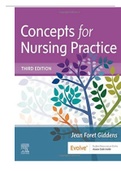Exam (elaborations)
TEST BANK CONCEPTS OF NURSING PRACTICE(WITH ACCESS ON VITAL SOURCE) 3RD EDITION GIDDENS>CHAPTER 1- 57<COMPLETE GUIDE
- Course
- Institution
- Book
TEST BANK CONCEPTS OF NURSING PRACTICE(WITH ACCESS ON VITAL SOURCE) 3RD EDITION GIDDENS>CHAPTER 1- 57<COMPLETE GUIDE
[Show more]



